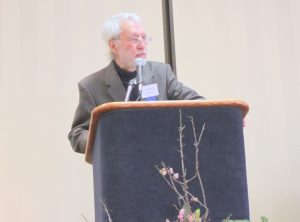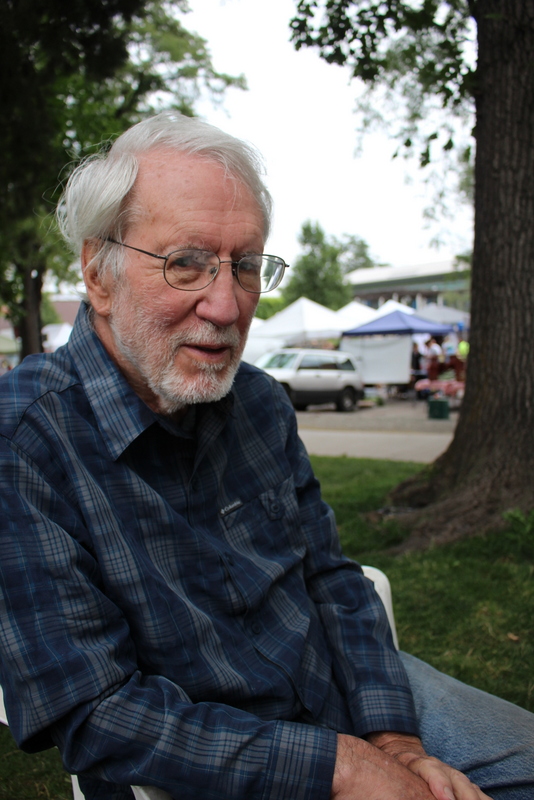Editor’s Note: Those working to promote peace and justice have “priority boarding” to the front of the line at The Nation Report. Events that shaped the work of peace and social justice activists are brought to the forefront of memories that they share with our readers. Over the course of talking to activists, we have discovered that profound events have contributed to the direction of their life’s work for some activists, and for others it was exposure to a series of events such as a supportive (or in some cases a violent) upbringing that led people to change the world.
LeRoy Moore turned ten the day Pearl Harbor was bombed in 1941. Four years later he learned of the bombing of Hiroshima the next morning before his paper route. He was a paper boy for the Dallas Morning News and by 4:30 or 5:00 a.m. he read the details of the bombing. He initially felt proud that his country was right and the other side was wrong.
It was in 1969 while teaching a seminary that he realized three threats to humanity: 1. The threat of nuclear holocaust 2. The threat of an environmental catastrophe, and 3. The threat of an authoritarian government.
LeRoy Moore of Boulder was raised in Texas and points to experiences in his early life that led him to where he is today. He is a member of the Rocky Mountain Peace and Justice Center and of the subgroup Rocky Flats Guardianship Program. Moore has studied the effects and health impacts of the Rocky Flats nuclear weapons plant for over 30 years. Moore participated in an annual memorial to the victims of the World War II bombings of Hiroshima and Nagasaki in Boulder’s Central Park in August 2016 where he shared his background with The Nation Report.
In 1974 he began teaching at the University of Denver and had never heard of Rocky Flats. It wasn’t until the 1978 historic occupation of the tracks outside of Rocky Flats by the Rocky Flats Truth Force that he learned of the nuclear weapons being built at the plant. When he learned more, he realized that Rocky Flats represented all three threats that he outlined in his early career. In April of 1979, he sat on the tracks himself in an act of civil disobedience to stop the construction of nuclear weapons.
Upon becoming more educated about the impact of the plutonium produced at the plant and the virtual eternal effects of the contamination, he realized that even stopping nuclear war meant that twice 24,000 years – the half life of plutonium – of future generations would have to deal with the environmental destruction. Moore continues the work to keep current and future generations off of the site and to inform those who purchase or are thinking of purchasing new homes near the site, of the history surrounding the contamination.
At eight-years old his Southern Baptist Sunday school teacher instructed his class, “I want you to watch out for n-ggers. They’ll push you off the walk.” Moore said that there were several Black families in the Dallas area, and that he had never had an experience close to what his Sunday school teacher was describing. He began to question the integrity of what he was being taught in church.
Moore shares details of a harrowing childhood experience and memories of a violent and abusive childhood. Perhaps contributing most to Moore’s early sense of justice was his namesake, his father. Moore describes his father as “disagreeable and domineering.” He lost his mother at a young age and his father raised him and his five siblings. “He was very violent toward me when I did something he didn’t like.”
LeRoy Moore in his own words:
“Most of the time I thought it was insignificant the differences between us, but he would get angry and he started when I was very small with just a little switch. [He would say], ‘Go out in the yard and get me a switch from one of the shrubs and take the leaves off of it and bring it to me.’ Then he would hit me on the bare legs. And that was bad, but over time he escalated. He used the belt. He used the ruler. It was hard. And eventually by the time I was a teenager, he was using a rubber hose. He didn’t hit anybody else with that but me. He had a piece of garden hose about 6 ft. long that he doubled over, and he would hit me with that.
When I was 16-years old on the very last day of my Junior year in high school I had gone to a party on Thursday night, the day before our report cards were going out on Friday. And I told [my father] going home on Sunday night, the previous Sunday night we were at church.
The Wickers, the people who were kind of the overseers of our youth group at the church that I was a part of invited us to come to their house on Thursday night for a big party, an end-of-the-school year party. They had a couple of kids that were just my age. And they invited our group to come there and that would be a lot of fun. It always was. And I was sitting next to Shirley Green. And my heart was like ‘this’ for her you know, and I said, ‘Shirley!’ I turned to her. She was [sitting as] close as I am to you. And I said, ‘Can I take you to that party?’ And she said, ‘Yes.’ So I was real pleased.
Well Shirley was from a very poor family and they lived way across the city of Dallas from where I lived. And they didn’t have a telephone at her house. But anyway going home after church that night in the car I told my father that the Wickers were having a party on Thursday night and that I was going and I was taking Shirley Green with me to the party. I was going to go all the way to her house and we would catch the bus and the trolley and transfer two or three times and finally end up at the Wickers for the party. And he said, ‘What night is that?’ and I said, ‘Thursday night.’ And he said, ‘You can’t go.’ And I said, ‘Why’s that?’ And he said, ‘It’s a school night. You know you’re not to go out on a school night.’ And I said, ‘It’s not really a school night. School is all finished by that day. We’ve already had our exams. All we have to do on the last day, Friday, is go to school in the morning, get our yearbooks, get teachers and students to sign them and we don’t even stay for lunch. We come home. It’s all over.’ And he said, ‘No. It’s a school night. You can’t go.’ I said, ‘Well I’m going to go.’ And he said, ‘No you’re not.’
And all week long we argued this back and forth. And finally Thursday when I was going to school and he was going off to his work, I said, ‘I’m going to go get Shirley and go to that party when school is over today.’ And he said, ‘No you’re not.’ And I said, ‘Yes I am.’ And he left, and I left.
When I came home at the end of the day, I left my books and I went to catch the trolley car and I went to get Shirley. And we went to the party. At the party the phone rang one time and I heard Mr. Wicker talking on the telephone and I realized from the way he was talking, it must be my father. And it was my father who was reading him the riot act. They were both deacons in the church and he was telling Mr. Wicker what a bad thing it was to have a party and Mr. Wicker was trying to explain it. But anyway I went to the phone. I had to go to the phone and my father said, ‘I want you to come home immediately.’ And I said, ‘As soon as I take Shirley Green back to her house, I’ll come home.’ So about midnight, I actually got home. I walked back into the house. And I walked down the hall toward the bedroom I shared with my brother. And when I was in the hallway – it was dark – but then I realized that my father was there at the far end of the hall and that he had this rubber hose in his hand. And sure enough when I got up to him he said, ‘I want you to lie down on that bed’ like I’d always done. And he ordered me to lie down on the bed so that he could hit me.
And all of a sudden it came to me that I didn’t have to do this anymore. And I refused to do it. And then he started trying to wrestle me down. I put my arms around his neck like that, and I lifted my feet from the floor and I hung in front of his body. It must have been 90 degrees. It was around the first of June in Dallas, Texas where it was very hot. And the sweat was breaking out all over his body. In just a few seconds he just went totally limp with exhaustion. So when that happened, I took my hands off and stepped back. And that was the last time he made any effort to hit me with a hose or anything else.
The psychological dimension was there until he died, but he made no other effort to try to stop me. This was 1948.”
Years later when Moore first began activism in the 1970’s to close the Rocky Flats nuclear weapons plant, he was required to complete nonviolent civil disobedience training to be able to join others in sitting on the railroad tracks. During this time activists blocked train deliveries and pickups by sitting on the tracks outside of the nuclear weapons plant. Incredibly to Moore, part of the training involved the exact technique that he inherently used in self-defense to prevent the last assault attempt by his father. Moore had wrapped his arms around his father’s neck and hung using his dead weight, “I had put into practice something that was now being used in a carefully organized nonviolence training.”

LeRoy Moore speaks after receiving the Daily Camera Pacesetters’ Award for Science/Medicine/Health in 2011. (All photos: The Nation Report)
Rocky Flats was closed in the early 1990’s but the activism continues. One area of the site is owned by the US Department of Energy, has been designated a “Superfund” site, and is off-limits to the public. The Rocky Flats Guardianship Program of the Rocky Mountain Peace and Justice Center would like to see the entire area off-limits to the public because of the wind and water that has transported plutonium and other contaminants. Still, the US Fish and Wildlife Service manages a portion of the site calling it the Rocky Flats National Wildlife Refuge. Fearing contamination to visitors, including children on school trips, the Guardianship Program is pushing to have the site closed. The DOE is completing its periodic 5-year review of environmental data to evaluate the site’s designation as clear for “unrestricted use.” The public comment portion of this review will close on December 31, 2016.
His advice to the next generation of peace activists is to, “Seek the truth, speak the truth, live the truth, and do not forget what your heart tells you.”
